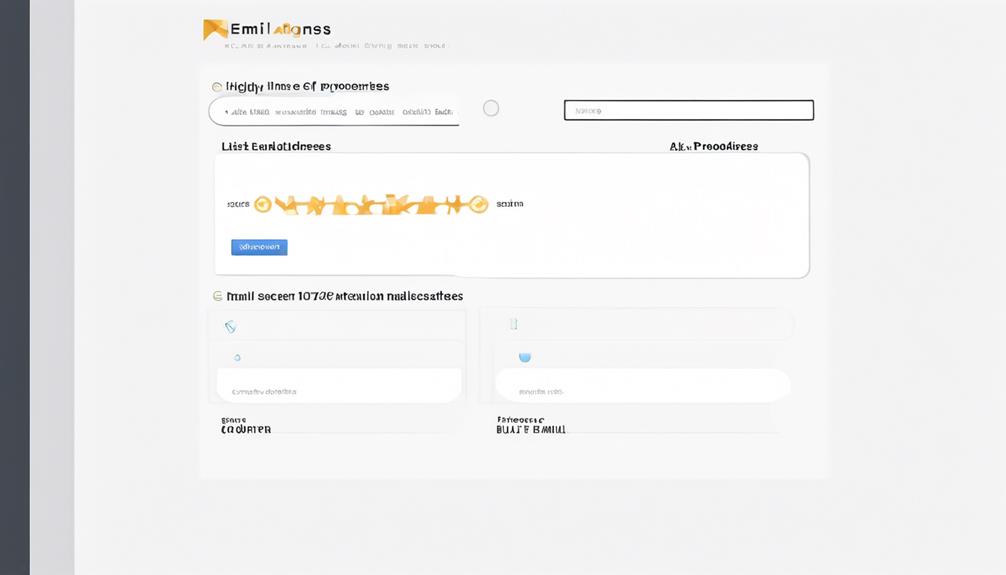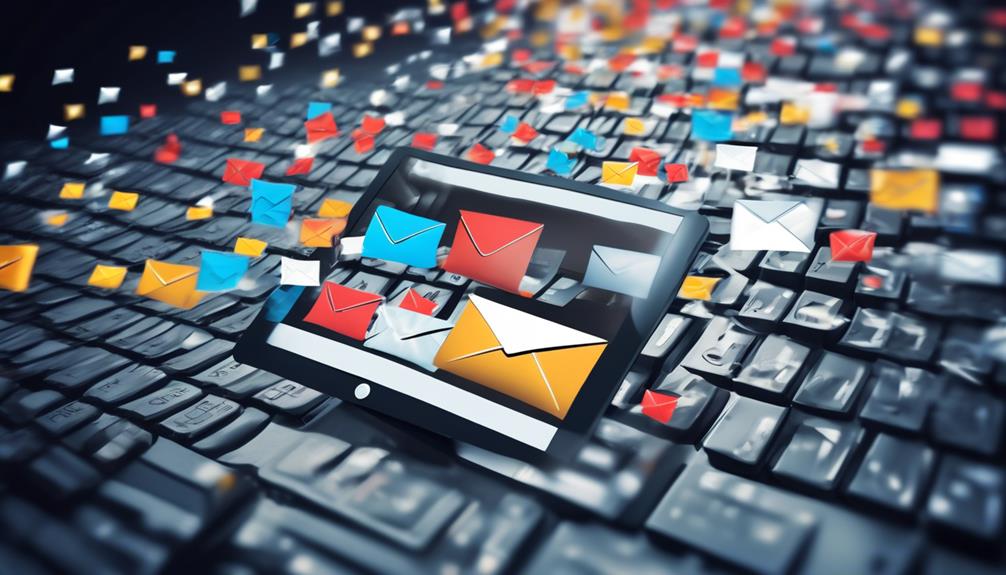Sending a bulk email is like casting a wide net in the vast sea of digital communication, reaching multiple recipients in one go. What exactly is involved in this process, and how does it differ from regular email exchanges?
Let's uncover the layers of bulk email, exploring its purpose, mechanics, and potential impact. Understanding the intricacies of bulk email can provide valuable insights into its relevance and effectiveness in today's digital landscape, making it an essential topic to explore for anyone navigating the realm of online communication.
Key Takeaways
- Bulk email is a powerful tool for streamlining communication with a large audience simultaneously, making it efficient for marketing, newsletters, updates, and more.
- Personalization and automation enhance the effectiveness of bulk email campaigns, allowing for targeted messaging and segmentation to generate leads and improve engagement.
- Tracking and analyzing campaign performance is crucial for enhancing marketing strategies, and bulk email provides a cost-effective way to reach a wide audience and track performance metrics.
- Implementing bulk email campaigns requires visually appealing templates, personalized content, interactive elements, and optimization of subscription forms to gather relevant information and understand audience preferences and behaviors.
What Is Bulk Email?
Bulk email streamlines communication by delivering a single email campaign to a large audience simultaneously, making it an efficient tool for marketing, newsletters, updates, and more. Essentially, the bulk email meaning revolves around the ability to send mass emails to a substantial number of opted-in subscribers.
This process, also known as sending bulk emails, requires the use of a robust email marketing platform. These platforms provide various essential tools such as pre-designed, mobile-responsive email templates, drag-and-drop builders, design and spam check utilities, send time optimization, and engagement segments.
When utilizing bulk email services, personalization and automation play pivotal roles in enhancing effectiveness. Personalization allows for tailoring content based on the recipient, while automation facilitates personalized content delivery.
The benefits of sending bulk emails are multifaceted. Not only does it allow for efficient communication with a large group, but it also proves to be cost-effective and enables wide audience reach. Additionally, the targeted messaging capabilities and the ability to track performance metrics make bulk email an indispensable tool in modern marketing strategies.
In essence, bulk email services offer a streamlined, efficient, and highly effective means of reaching and engaging with a large audience.
Understanding Bulk Email Software

Understanding bulk email software is crucial for maximizing the efficiency and effectiveness of mass email campaigns, as it provides the necessary tools and features for seamless management and delivery.
When selecting a bulk email marketing platform, it's essential to consider its capability to handle a large volume of email addresses and deliver messages reliably.
A robust bulk email software offers mobile-responsive templates and drag-and-drop builders, enabling the creation of visually appealing and engaging email content.
Additionally, the ability to segment recipients based on their engagement ensures targeted and personalized communication, enhancing the impact of the emails.
Automation features further streamline the process, allowing for timely and relevant messages to be sent automatically.
Furthermore, subscription management tools help in maintaining a clean and compliant email list, while performance reports provide valuable insights for refining future campaigns.
Benefits of Bulk Email Marketing
Bulk email marketing offers a multitude of benefits for businesses. This includes cost-effective outreach and the ability to reach a wide audience. By utilizing targeted messaging and segmentation, companies can generate leads and improve engagement.
With the added perks of tracking and analyzing campaign performance, bulk email marketing is a powerful tool for enhancing marketing strategies.
Cost-Effective Marketing
To truly grasp the benefits of cost-effective marketing through bulk email campaigns, it's essential to understand the potential for efficient communication with a large group of subscribers. When considering the cost-effectiveness of bulk email, it's important to recognize the emotional impact it can have on the audience.
Here's how it can evoke emotion:
- Personal Connection: Bulk email allows for personalized messages, fostering a sense of connection and loyalty among subscribers. Subscribers feel valued and understood, leading to stronger brand affinity and customer retention.
- Convenience and Accessibility: By reaching subscribers directly in their inboxes, bulk email marketing provides convenient access to valuable information, creating a sense of exclusivity and importance.
Wide Audience Reach
Fostering a strong emotional connection through personalized messaging, bulk email marketing offers the added benefit of reaching a wide audience, amplifying the impact of cost-effective marketing strategies. By sending out mass emails, businesses can connect with a vast number of potential customers in a targeted and efficient manner.
This wide audience reach allows for the dissemination of tailored content to specific segments, maximizing the relevance of the communication. Through bulk email, businesses can engage with diverse demographics, ensuring that their message reaches a broad spectrum of recipients.
The ability to connect with a wide audience enables companies to expand their brand presence and increase the likelihood of conversions. Leveraging the power of bulk email for wide audience reach is instrumental in achieving marketing objectives and driving business growth.
Differentiating Bulk Email Types

When categorizing different types of bulk emails, marketers rely on a range of strategies to effectively engage their audience and drive desired actions. To differentiate bulk email types, it's important to understand the diverse purposes they serve. Here's a breakdown:
- Transactional Emails: These are essential for building trust and confidence. They include order confirmations, shipping notifications, and password resets. They evoke a sense of reliability and professionalism, reassuring customers about their interactions with your brand.
- Sub-list: They provide a sense of security and reliability, fostering positive customer experiences.
- Promotional Emails: Designed to entice action, these emails offer discounts, promotions, and product launches. They aim to evoke excitement and a sense of urgency, compelling recipients to make a purchase or engage with your brand.
- Sub-list: These emails generate anticipation and excitement, driving customer engagement and sales.
Implementing Bulk Email Campaigns

When it comes to implementing bulk email campaigns, there are two key factors that play a crucial role in their success: designing effective templates and managing recipient engagement.
Crafting visually appealing and mobile-responsive templates is essential. This is because the design of the email can greatly impact open and click-through rates. A visually appealing template will catch the recipient's attention and increase the chances of them opening the email. Similarly, a mobile-responsive template ensures that the email looks good and functions properly on various devices, such as smartphones and tablets.
Managing recipient engagement is another critical aspect of bulk email campaigns. It involves understanding how to segment and personalize content to maximize recipient engagement. By segmenting the email list based on various criteria, such as demographics or past behaviors, you can tailor the content to be more relevant to each recipient. Personalizing the content helps to create a sense of individual connection and increases the likelihood of recipient engagement.
Designing Effective Templates
To create effective templates for implementing bulk email campaigns, it's essential to focus on captivating design and personalized content that resonates with the target audience. When designing email templates for bulk email marketing, consider the following to evoke emotion in the audience:
- Utilize compelling visuals: Incorporate eye-catching images and graphics to draw the recipient in and create a visually appealing layout.
- Craft persuasive copy: Use language that speaks directly to the recipient, addressing their pain points and offering solutions.
Managing Recipient Engagement
Engaging recipients in bulk email campaigns involves crafting personalized content and utilizing interactive elements to foster meaningful connections with the audience. Personalization allows for tailored messages that resonate with subscribers, increasing the likelihood of engagement.
Utilizing interactive elements, such as surveys, polls, and quizzes, encourages active participation and feedback, creating a two-way communication channel. Additionally, optimizing subscription forms to gather relevant information enables targeted content delivery, enhancing recipient engagement.
By understanding the preferences and behaviors of the audience, marketing emails can be tailored to provide value and relevance, leading to higher open rates and click-throughs.
Managing recipient engagement involves building relationships through personalized, interactive, and targeted communication, ultimately maximizing the effectiveness of bulk email campaigns.
Economical Aspects of Bulk Emails

Sending bulk emails can significantly reduce marketing costs while efficiently reaching a wide audience with targeted messages and personalized content. This approach not only saves money but also maximizes the impact of marketing efforts.
Consider the following economical aspects of bulk emails:
- Cost-effectiveness: Bulk email campaigns eliminate the need for expensive printed materials and postage, resulting in substantial cost savings for businesses. This allows for the reallocation of resources to other essential areas of operations, fostering business growth and development.
- Efficiency and scalability: With bulk email services, reaching a large group of subscribers is streamlined, ensuring that marketing messages are delivered promptly and consistently. This efficiency enables businesses to focus on creating compelling content and strategies to engage their audience effectively.
Imagine the satisfaction of achieving marketing goals while optimizing resources and staying within budget. This can bring a sense of accomplishment and empowerment to businesses, allowing them to thrive and expand their reach.
Picture the relief and confidence in knowing that your message is reaching a vast audience without the constraints of traditional communication channels. This sense of control and efficiency can instill a sense of confidence and competence in businesses, driving them towards success.
Selecting a Bulk Email Service

When choosing a bulk email service, it's important to consider the features that will best suit our needs. Key features to consider include customizable templates, automation options, and analytics tools. These features can help us create professional-looking emails, automate our email campaigns, and track the performance of our campaigns, respectively.
We also need to weigh the pricing and plans offered by different services to ensure we're getting the best value for our budget. It's essential to compare the costs of various service providers and consider any additional fees that may be associated with certain features or usage limits.
Additionally, looking into integration options with our existing systems can streamline our workflow and enhance our overall communication strategy. Integration with our customer relationship management (CRM) system or e-commerce platform, for example, can allow us to easily sync customer data and automate email campaigns based on specific triggers or events.
Features to Consider
Selecting a bulk email service requires careful consideration of various features to ensure effective email campaigns and compliance with regulations.
When choosing a service, we should prioritize premade, mobile-responsive email templates to present a professional image.
Additionally, look for tools that enable personalization and automation, enhancing the impact of bulk emails.
It's crucial to opt for a service that provides comprehensive performance reports, allowing us to track the effectiveness of our email campaigns.
Furthermore, compliance with regulations such as the CAN-SPAM Act is essential, so consider services that offer subscription management tools.
Lastly, efficiency in managing large mailing lists and delivering mass emails per month is vital.
Pricing and Plans
To make an informed decision when choosing a bulk email service, it is essential to carefully review the pricing and plans offered by various providers. When considering pricing and plans for bulk email services, it's crucial to assess the number of email blasts allowed, subscriber limits, and additional features such as automation, personalization, and analytics. Here's a comparison table to help you evaluate different options:
| Provider | Price/Month | Emails Per Month | Subscriber Limit | Additional Features |
|---|---|---|---|---|
| Provider A | $50 | 10,000 | 2,000 | Automation, A/B Testing, Advanced Analytics |
| Provider B | $30 | 5,000 | 1,000 | Custom Templates, Segmentation, Real-time Reports |
| Provider C | $80 | 15,000 | 3,000 | Behavioral Targeting, API Access, Dedicated IP |
Carefully analyzing these aspects and matching them with your specific requirements can help you select the most suitable bulk email service for your needs.
Integration Options
Exploring integration options for a bulk email service enhances our ability to seamlessly connect with existing platforms or systems, maximizing marketing automation and customer relationship management capabilities.
When selecting a bulk email service, robust integration options evoke confidence and excitement, knowing that our email messages can effortlessly sync with our CRM systems and e-commerce platforms. This capability enables highly personalized and targeted messaging, fostering stronger connections with our audience.
Moreover, the potential to integrate with analytics tools and social media platforms sparks enthusiasm, as it can provide valuable insights and expand the reach of our bulk email campaigns.
Embracing these integration options empowers us to elevate our email marketing strategy, ensuring that our messages resonate and drive meaningful engagement.
Sending Bulk Emails Responsibly

Sending bulk emails responsibly requires careful consideration of the recipients' expectations and compliance with relevant regulations.
As senders of bulk email, we must prioritize maintaining a positive sender reputation by ensuring that our emails are welcomed by recipients. This involves obtaining permission from subscribers and providing an easy and accessible unsubscribe link in every email. By doing so, we demonstrate respect for the recipients' preferences and comply with regulations such as the CAN-SPAM Act, which mandates the inclusion of an opt-out mechanism in commercial emails.
Moreover, responsible bulk email sending involves maintaining a clean and updated email list. Regularly removing inactive or disengaged subscribers helps to improve deliverability and ensures that our messages reach the intended audience. Additionally, monitoring and analyzing email engagement metrics can provide valuable insights into the effectiveness of our campaigns, allowing us to refine our strategies and deliver more relevant content.
In essence, sending bulk emails responsibly not only safeguards our sender reputation but also fosters trust and goodwill with our audience. It's a crucial aspect of successful email marketing that aligns with ethical practices and regulatory requirements.
Examples of Bulk Email Usage

Bulk email usage encompasses a wide range of applications, from marketing campaigns to customer communication and event promotions. Examples of bulk email usage include:
- Engaging Customers: Sending personalized product recommendations and exclusive offers to build customer loyalty and drive sales, creating a sense of exclusivity and urgency. The goal is to evoke a feeling of excitement and anticipation, prompting the audience to take immediate action and make a purchase.
- Event Promotions: Notifying subscribers about upcoming events, workshops, or webinars, with interactive content and registration links to encourage participation and engagement. This creates a sense of community and belonging, making recipients feel valued and eager to be part of the experience.
Bulk email usage is a powerful tool for businesses to connect with their audience on a large scale, driving engagement and fostering relationships. By sending emails that resonate with recipients, businesses can achieve their marketing objectives and build a loyal customer base.
Best Practices for Bulk Email

To maximize the impact of your bulk email campaigns, it is essential to implement best practices that ensure efficiency, compliance, and engagement with your audience. By following these best practices, you can enhance the effectiveness of your bulk email marketing efforts.
| Best Practices for Bulk Email | ||
|---|---|---|
| 1. Segmentation | 2. Personalization | 3. Automation |
| Segment your email list based on demographics, behaviors, or past interactions to send targeted and relevant content. | Personalize your emails by addressing recipients by their names, tailoring content to their interests, and sending personalized product recommendations. | Use automation tools to schedule emails, trigger messages based on user actions, and nurture leads through automated workflows. |
| 4. Compliance | 5. Testing and Optimization | |
| Ensure compliance with anti-spam laws such as the CAN-SPAM Act and obtain consent from recipients before sending emails. | Test different elements of your emails, including subject lines, content, and send times, to optimize performance and engagement. |
Implementing these best practices will not only improve the efficiency of your bulk email campaigns but also enhance engagement with your audience, leading to better results and a positive brand reputation.
References for Bulk Email Marketing

As we consider the essential references for bulk email marketing, it's crucial to understand how implementing best practices can significantly impact the effectiveness of our email campaigns.
When sending a bulk email, it's vital to refer to reliable sources for guidance and inspiration. Here are some key references to elevate your bulk email marketing game:
- Industry Leaders: Seek advice and insights from reputable industry leaders who've demonstrated success in crafting compelling email blasts. Their expertise can provide valuable strategies and tactics to enhance your email messages.
- *Emotion-evoking Subject Lines*: Industry leaders often emphasize the importance of crafting subject lines that evoke emotion, driving higher open rates and engagement.
- *Segmentation Strategies*: Leveraging audience segmentation techniques recommended by industry leaders can significantly improve the relevance and impact of your email campaigns.
What is the Definition of Bulk Email and How is it Different from Regular Email?
Bulk email marketing involves sending promotional emails to a large number of recipients at once. Unlike regular email, which is generally personalized and targeted to specific individuals, understanding bulk email marketing requires a focus on reaching a wider audience and increasing brand visibility.
Frequently Asked Questions
What Is Bulk Mail in Gmail?
We use Gmail for sending bulk emails. This means we send a single email to a large group of recipients at once. This is commonly used for marketing messages, newsletters, updates, coupons, and invitations.
Gmail's email platform offers tools for easy creation, sending, and delivery of bulk emails. It's a great way to reach and engage a wide audience effectively.
Is Bulk Email Known as Spam?
No, bulk email isn't necessarily known as spam. While some bulk emails may be unsolicited and end up in spam folders, legitimate bulk email marketing involves sending messages to opted-in subscribers who've consented to receive communications.
What Is the Difference Between Bulk Email and Mass Email?
Sure, the difference between bulk email and mass email lies in their purpose and audience.
Bulk email is targeted and personalized, often used for marketing and communication with subscribers.
Mass email, on the other hand, is more generic and sent to a wider audience without as much personalization.
Understanding this distinction can help you tailor your email campaigns for better engagement and results.
What's the Difference Between Bulk Email and Junk Mail?
The difference between bulk email and junk mail is that bulk email refers to legitimate, targeted messages sent to a large group, often for marketing or informational purposes. It is a strategic approach to reaching a wider audience with relevant content.
On the other hand, junk mail typically consists of unsolicited, often irrelevant or unwanted messages. It is often associated with spam and unwanted solicitations.
Bulk email allows organizations to communicate with their intended audience in a cost-effective and efficient manner. It can be personalized and tailored to specific recipients, providing relevant information and offers.
Junk mail, on the other hand, is often sent without the recipient's consent and can clutter their inbox with unwanted messages. It is often seen as a nuisance and can be a source of frustration for individuals.
Conclusion
In conclusion, bulk email marketing is like casting a wide net to reach a large audience. Just like a fisherman carefully selects the best bait and location to catch the most fish, businesses must strategically craft their bulk email campaigns to engage and attract the right audience.
By using the right tools and best practices, businesses can effectively leverage the power of bulk email to drive engagement and achieve their marketing goals.










